These Hidden Easter Eggs in Iconic Works of Art Only Make Them More Spectacular
If you’ve ever looked at a piece of art and thought there’s more to it than meets the eye, you are probably right–and you are also not alone. Numerous artists have placed hidden symbols and meanings in their work for reasons only they definitively know.
Some of these are easy to spot, while others take a little more digging to uncover. If you are one of the few who enjoy going deep into the rabbit hole and discovering the hidden meanings of artistic works, sit back, relax and enjoy all the odd details our list offers.
The Last Supper Was Not An All-Male Event?
The Last Supper is a popular painting not only because it is literally massive, as it takes up a large space on the wall of Milan’s Convent of Santa Maria delle Grazie, but also due to its creator–Leonardo da Vinci.
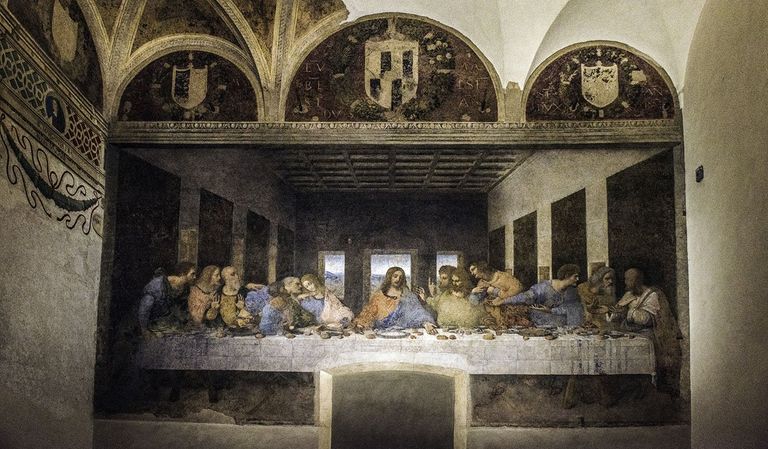
Source: Mark Edward Harris/Getty Images
Considered a true Renaissance Man, da Vinci worked on the painting during the late 15th century. The image depicts Jesus as he tells his 12 disciples that one of them will betray him. It’s one of the most recognizable paintings in the world and is considered a masterpiece.
Revealing What The Catholic Church Didn’t Want Anyone To Know
A detail da Vinci included in the painting would make anyone see Jesus in a totally different light. Many believe that The Last Supper wanted to tell a story far different than what everyone has been told. A lot of people think that the person sitting next to Jesus isn’t one of his disciples but rather Mary Magdalene.
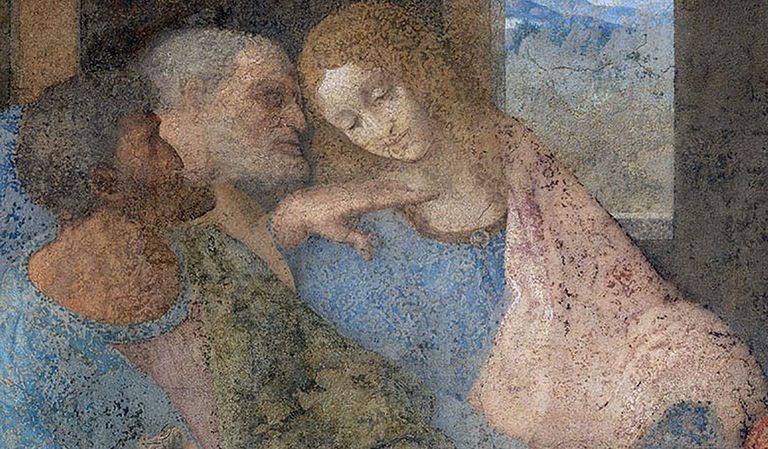
Source: Leonardo da Vinci
Pieces of evidence can be seen to back up this theory. For example, there’s a V-shape that appears between the two figures, which some claim is a symbol of the womb. There are also those who believe that da Vinci wanted to let everyone know that Jesus and Mary Magdalene were actually married.
The Deep Meaning In Dalí’s The Persistence of Memory
This painting has intrigued critics and art lovers for decades. It is a trippy artwork that shows numerous clocks melting in the sun. A lot of people have discussed the real meaning of Dalí’s painting, and a few are still trying to figure out what it wants to say.
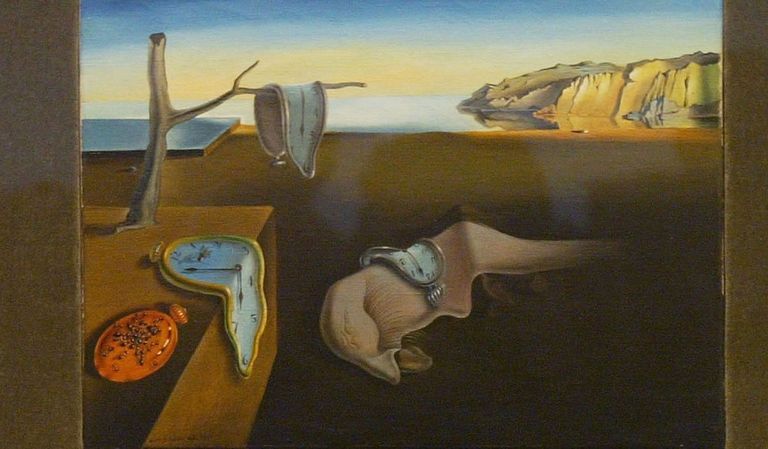
Source: Sean Gallup/Getty Images
Some believe that Dalí wanted to show how space and time are relative. Were the wilting and dripping clocks in the painting meant to represent the idea that there is no cosmic order?
Dalí Was Into Dairy
Fortunately, Dali was able to define the meaning of his painting solidly. Someone obsessed with the artwork felt compelled to ask the artist what it was all about–was The Persistence of Memory an artistic commentary on the theory of special relativity?
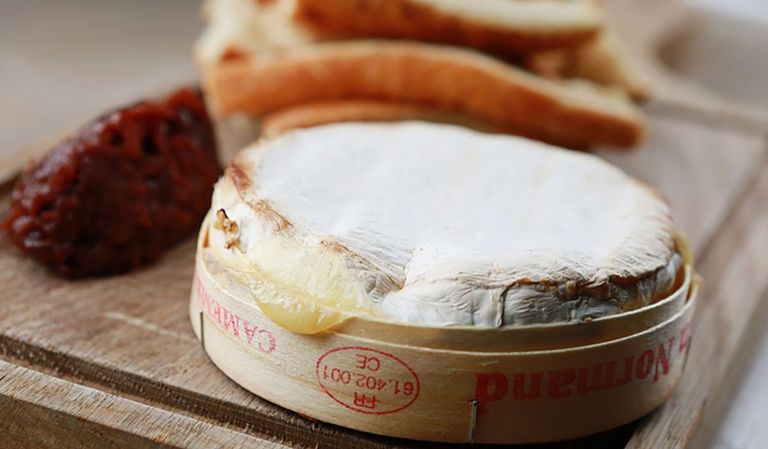
Source: Nick Bubb www.imagecaptured.co.uk/Getty Images
Or was the work a symbol of how much people waste time by spending their lives on material pursuits to the detriment of their souls’ sustenance? The artist said no to all these theories. Instead, he revealed that the melting clocks were just his surrealist take on Camembert cheese melting under the sun’s rays.
The Place Jesus Was Buried
Could a 17th-century painting actually hold the secret to Jesus’ final resting place? The painting in question is called The Arcadian Shepherds by Nicolas Poussin. Though painted in 1639, centuries after Christ’s crucifixion, many are intrigued by the detail it revealed.
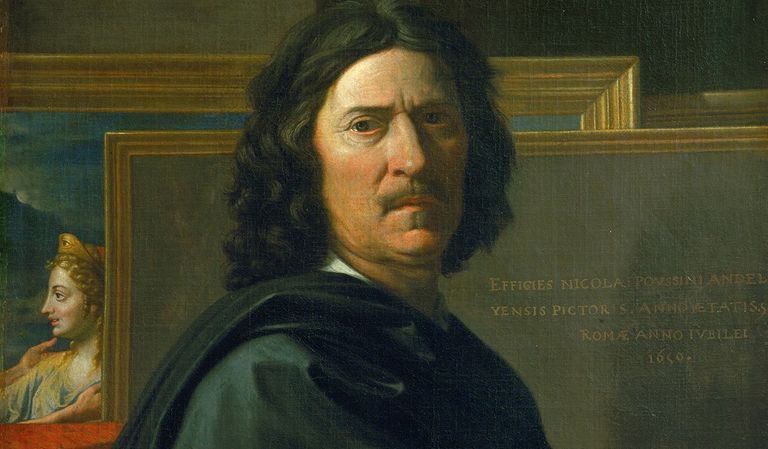
Source: Imagno/Getty Images
The artwork shows a group of shepherds and a woman hanging around a tomb with an inscription that says, “Even in Arcadia, I exist.” Though we are not art historians, it is safe to assume that’s a hint pointing to where Jesus might have been buried.
The Mystery Within A Mystery
Arcadia was a region in Greece that was considered a paradise. Many interpreted the inscription found on the tomb in the painting as a metaphor for how death comes for us all, no matter where we are.
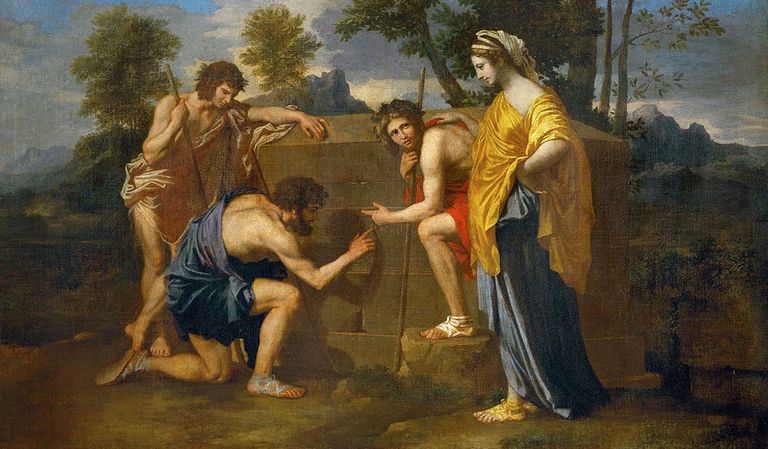
Source: Nicolas Poussin
But others say the inscription is an anagram for “Begone, I keep God’s secrets!” and that the tomb is actually holding Jesus’ remains.
Rembrandt Van Rijn’s Sneaky Self-portraits
In the art world, Rembrandt can be considered a jack of all trades. He not only painted like a professional genius, but he was also a draftsman and printmaker extraordinaire. As a result, he’s considered one of the all-time greats and the most important artist from the Netherlands.

Source: VCG Wilson/Corbis via Getty Images
But unlike some artists who get stuck in one particular style or subject matter, Rembrandt was a true Renaissance Man. He created landscapes, historical scenes, portraits, and self-portraits. However, some experts believe Rembrandt may not have painted all those self-portraits.
The Man In The Curved Mirror
It is easy to think of Rembrandt and remember the masterful brushstrokes and lifelike details in his paintings. But what if he actually had a little secret up his sleeve? Recent research has uncovered that Rembrandt used a 16th-century hack to create his realistic self-portraits.
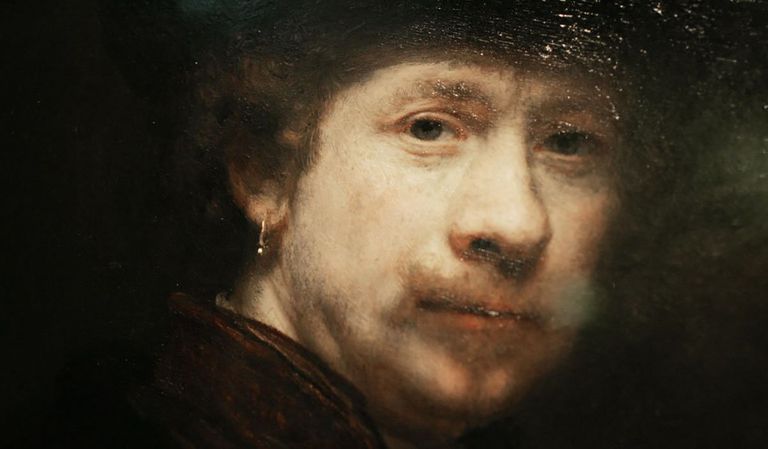
Source: JUAN VRIJDAG/AFP via Getty Images
Since he was painting a reflection of real life, he decided to use an object that would literally reflect life. So if you notice Rembrandt’s paintings tend to have a bright glow in the middle and dark edges–similar to what you would see when looking in a curved mirror–it’s because he used one.
Albrecht Dürer’s Hidden Messages
While current 20-year-olds are busy with their TikTok accounts, twenty-year-old Albrecht Dürer was already crafting woodcut prints during the Renaissance period.
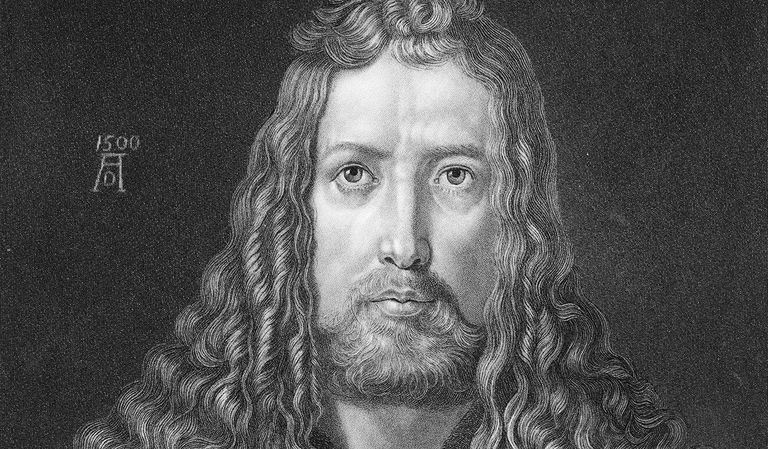
Source: Kean Collection/Getty Images
But wait, there’s more. The people buying his art highly likely had no idea that Dürer was also sending them secret messages through his work. Dürer was a master of hidden meanings as he sneaked in symbols and allegories that only the most discerning eyes could catch.
Camouflaged Jewish Symbols
Early Renaissance gossip about Albrecht Dürer seems to reveal that Dürer might not have been the devout Christian artist that he presented himself to be. If art historian Elizabeth Garner is to be believed, she theorizes that Dürer might have been secretly practicing the Jewish faith.
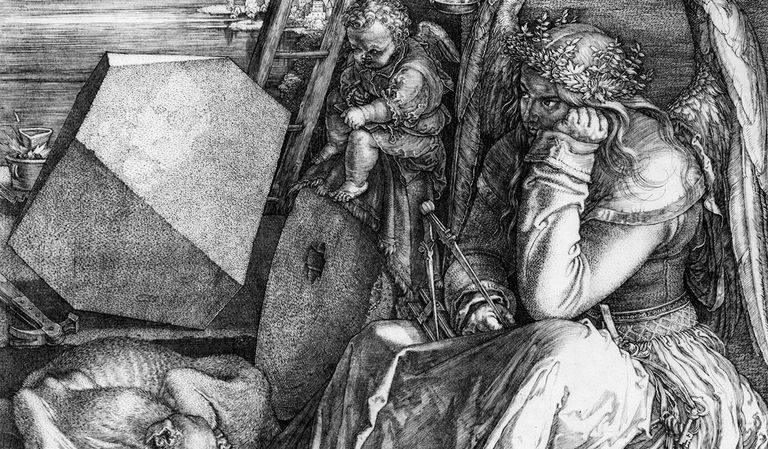
Source: ullstein bild/ullstein bild via Getty Images
Apparently, Albrecht was sneaking Jewish symbols into his Christian art. According to Art News Net, the German government was kicking Jewish people out at the time, and Dürer was apparently “bent on annihilating his Christian patrons.”
A Legal Record On A Painting
The artistic genius of Jan van Eyck is evident in his work, The Arnolfini Portrait. At first glance, it is easy to think it is merely a picture of the couple, Giovanni di Nicolao Arnolfini, a merchant, and his wife. But the painting is much more than that.
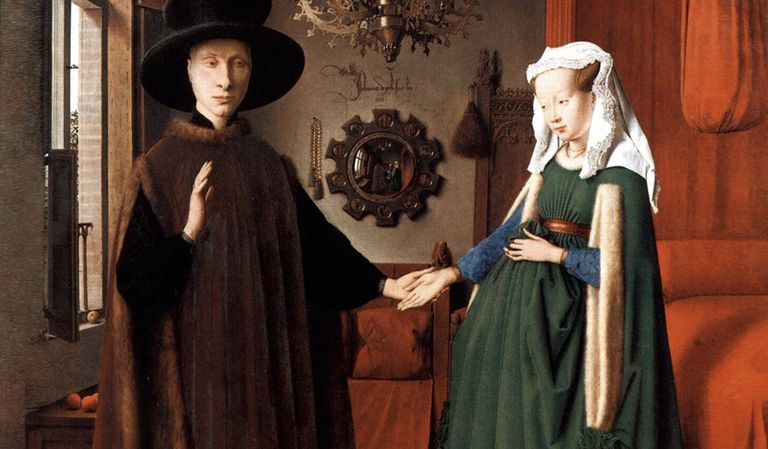
Source: Universal History Archive/Getty Images
Jan van Eyck was not only able to capture their essence as they seem to come to life right in front of our eyes, but the artist also created an accurately geometric room. His creation is simply a masterpiece.
A Secret Inside The Mirror
The statement, “the devil is in the details,” couldn’t be more true in Jan van Eyck’s The Arnolfini Portrait. In it, he proves he was not just a master painter but also an expert in subtlety. At first glance, it might just appear to be a portrait of a merchant and his wife. But in actuality, it is also a legal record of the couple’s wedding.
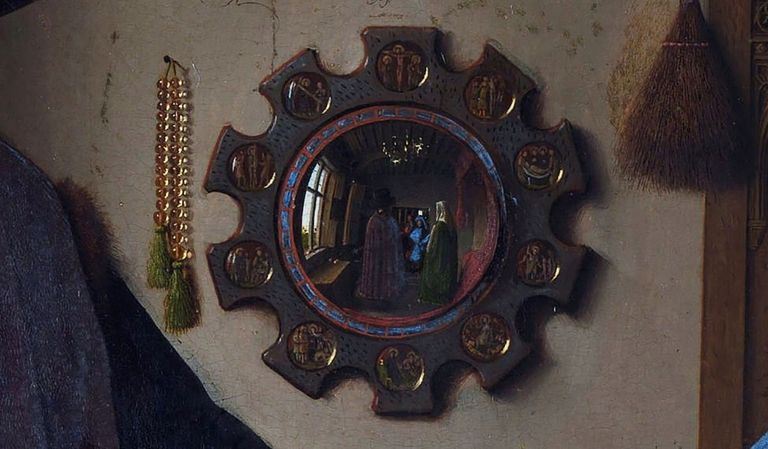
Source: Universal History Archive/Getty Images
His signature can be seen on the painting as “Jan van Eyck was here, 1434.” Also, the mirror reflects two figures standing in the room out of frame. Experts believe these figures were witnesses to the marriage. Essentially, The Arnolfini Portrait is a historical document, an artwork, and a masterful use of symbolism all in one.
The Adoration of the Magi Is Not A Feel-Good Painting?
Leonardo da Vinci is considered an artist, inventor, and scientist. There may have been nothing he couldn’t do. Most of the time, his genius prompts people to overthink the meanings behind his works. One such painting is The Adoration of the Magi.
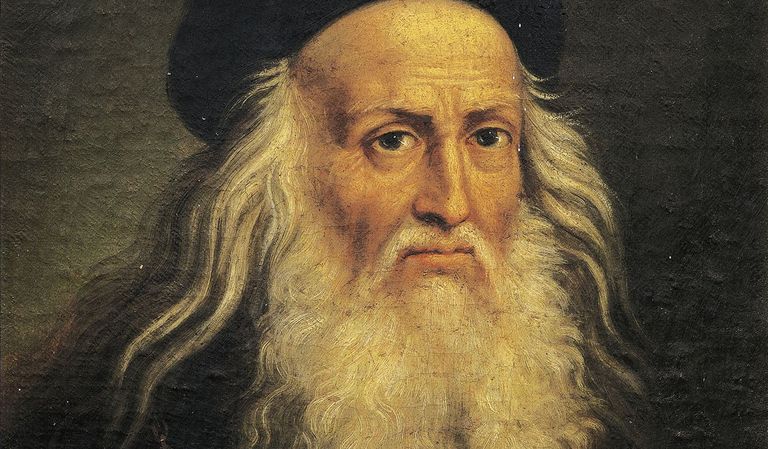
Source: DeAgostini/Getty Images
Though the image is fairly straightforward, as it shows baby Jesus receiving sweet gifts from the Three Kings, a ton of speculation surrounds this painting. A few claim that a more sinister meaning was intended by the painter.
The Painting Behind The Painting
Infrared imaging of The Adoration of the Magi revealed that da Vinci originally sketched a bloody battle scene, not a serene image of the infant Jesus. Who would have known that a peaceful nativity scene was supposed to be a battle zone?
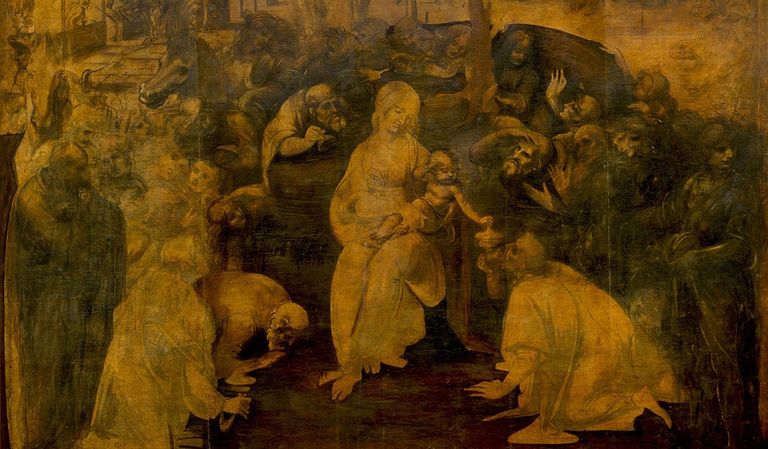
Source: Leonardo da Vinci
Some conspiracy theorists believe that the battle scene represents the violent re-establishment of paganism, which would have been a big no-no for the monks who commissioned the piece. Could it be da Vinci was trying to keep the peace with the religious powers of the time?
Johannes Vermeer Was A Tracer Not A Painter?
The Girl With a Pearl Earring is a famous painting that spawned a novel and a movie. But before Hollywood came knocking, its artist–Johannes Vermeer–was already killing the game with his incredible artwork.
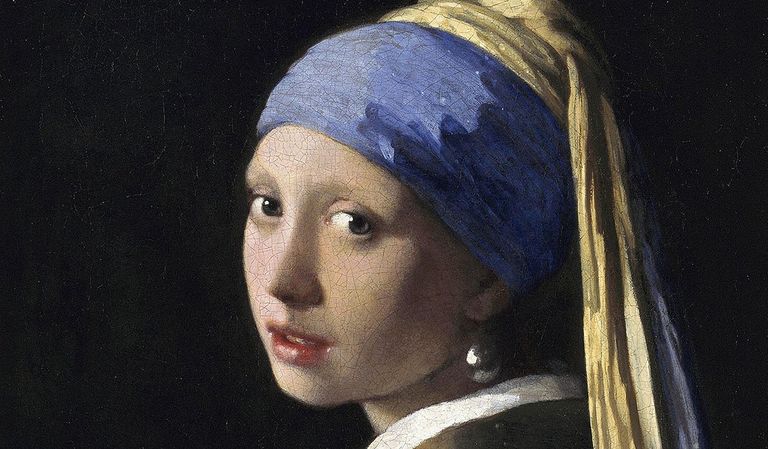
Source: VCG Wilson/Corbis via Getty Images
His attention to detail was so masterful that many likened his creations to a camera instead of a brush. His paintings were so realistic it was easy to mistake them for photographs.
Can Everyone Be Vermeer?
But rumors abound that Vermeer, the master of the art world and the man behind the iconic Girl With a Pearl Earring, may have had a secret weapon. It’s been suggested that the artist actually used a fancy camera obscura technique to project images onto his canvas and then traced them to create almost photo-realistic images.
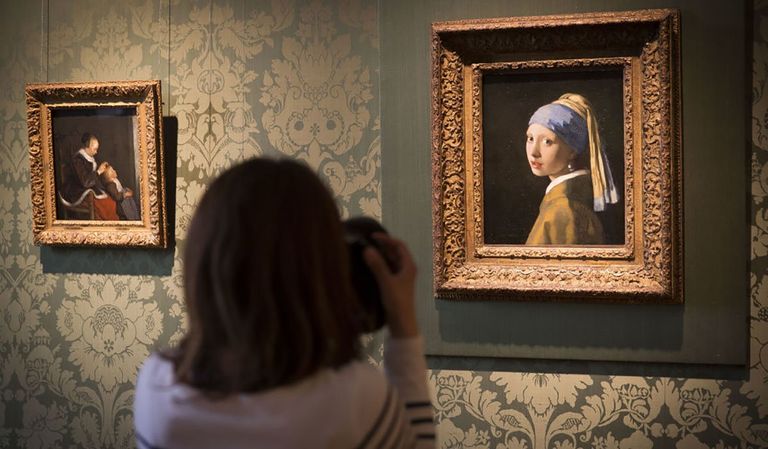
Source: Michel Porro/Getty Images
Even artist and art world doubter David Hockney theorized the same thing. Plus, someone named Tim Jenson–who was not even an artist–was able to recreate a Vermeer painting with ease using such a method.
A Glindoni Painting Revealed A Tudor Scientist Was Actually A Wizard?
Henry Gillard Glindoni, the man who made it look like a breeze to paint historical fashions and scenes, helmed an iconic piece that featured Tudor scientist John Dee. The artwork shows Dee presenting an experiment in front of Queen Elizabeth I and her court.
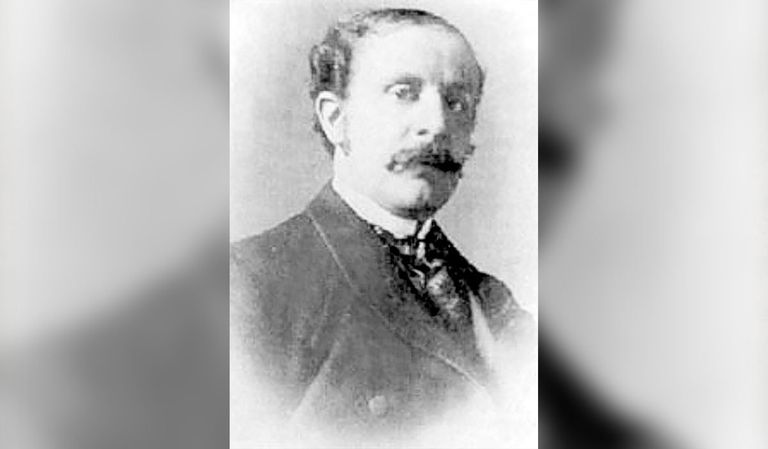
Source: Wikimedia Commons
However, this image is not what it seems to be, as x-rays of the painting have revealed a sneaky little secret. Was Glindoni just a master painter, or was he privy to some insider information?
The Hidden Skulls
Was history covering up a little secret about good ol’ John Dee? According to an x-ray image of Glindoni’s painting, it appears that Dee was originally depicted with a ring of skulls surrounding him.
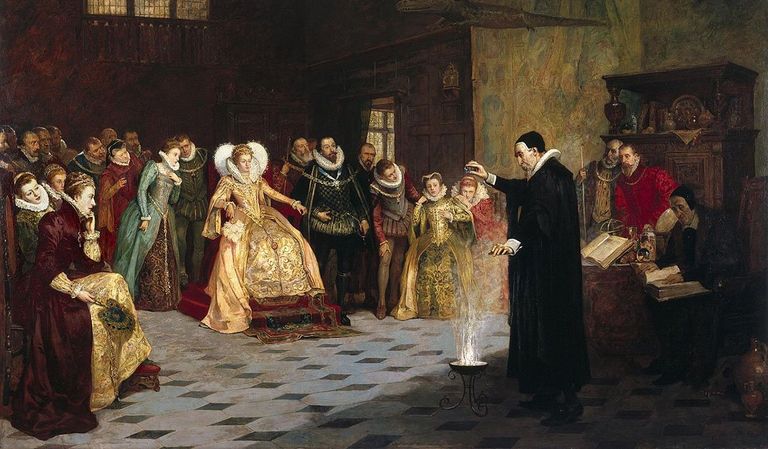
Source: Henry Gillard Glindoni
Why would a scientist have a ring of skulls? Was Dee dabbling in some dark magic back in the day, or was he simply presenting the royals with a basic Biology lesson about skulls? Unfortunately, we may never know because the artist painted over the skulls to prevent anyone from finding out about them.
Van Gogh May Have Been Inspired By Another Artist
Vincent van Gogh, the man who single-handedly revolutionized the art world with his post-impressionist masterpieces, may have been inspired by an equally great artist. But why would Van Gogh need inspiration from anyone else?
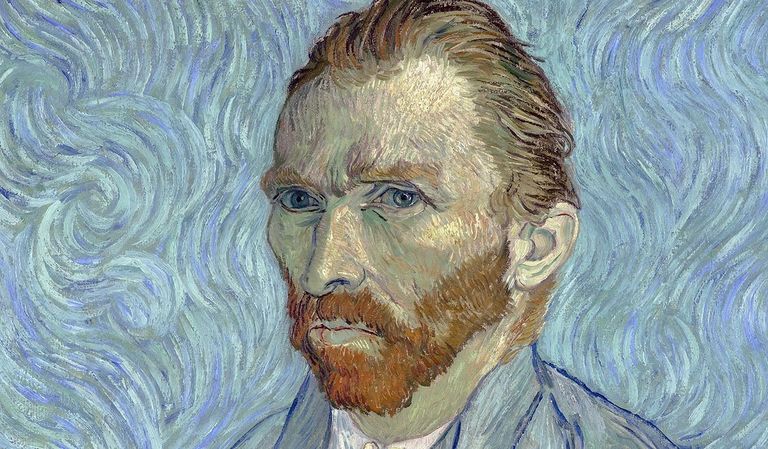
Source: VCG Wilson/Corbis via Getty Images
The man who created over 2,000 paintings in just 37 years apparently paid homage to another popular work of art in his 1888 painting Café Terrace at Night. Can you guess who the artist who inspired Vincent van Gogh was?
The Battle Between The Darkness And The Divine
It turns out that Vincent van Gogh’s beloved Café Terrace at Night may have been inspired by none other than Leonardo da Vinci’s The Last Supper. Apparently, there are a few signs that point to this theory.
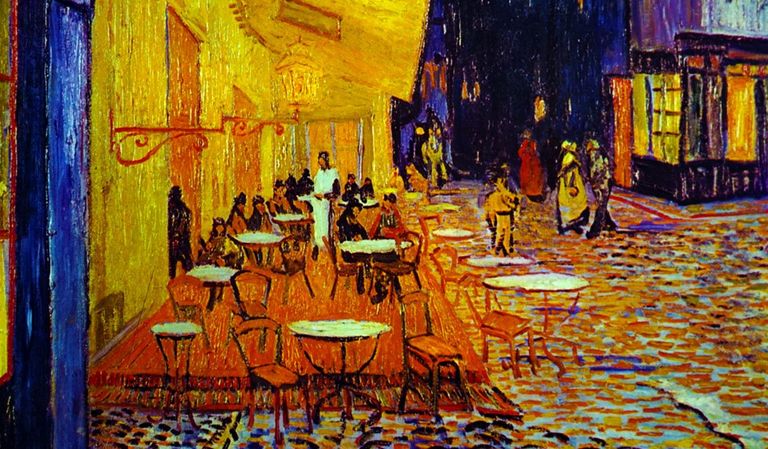
Source: Universal History Archive/Universal Images Group via Getty Images
The single waiter found in the painting looks suspiciously like Jesus. Plus, the window panes are similar to a cross. The shadowy figure in the café’s doorway could possibly be Judas. Plus, the lighting on the patio, compared to the dark street, could also symbolize the line between good and evil.
A Large Painting With A Giant Secret?
Rembrandt’s The Night Watch is a massive painting– literally. It measures 12 by 14 feet and possesses a level of realism that is almost otherworldly. It also showcases a perfect balance of light and shadow.
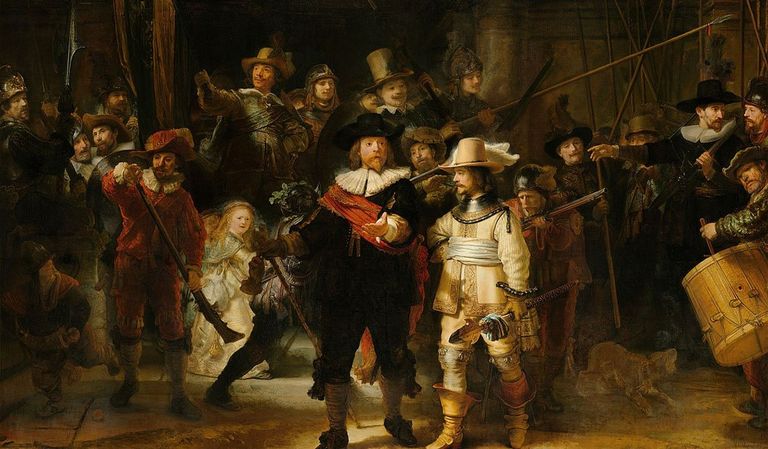
Source: Rijks Museum/Rembrandt
It was as if Rembrandt was trying to show off or reveal a piece of important information. The militiamen in the painting appear to be in motion. At that time, such an image was a relatively revolutionary concept, thereby making this painting a must-see for visitors to Amsterdam’s Rijksmuseum.
A Controversial Conspiracy Theory
Rembrandt’s The Night Watch may not just be an experiment in art techniques. It could actually be a secret message meant to reveal a sinister plot against his life, at least according to Director Peter Greenaway.

Source: VCG Wilson/Corbis via Getty Images
A group of civil militiamen seemed intent on not only threatening Rembrandt’s life but also ruining his career. This situation may be an excellent example of “art imitating life.” Still, no one would have actually suspected anything if not for Greenaway’s theory.
Goya Did Not Create The Black Paintings?
Francisco Goya’s The Black Paintings literally and metaphorically have a dark history. Goya was initially known as a romantic artist in his prime. However, as he got older, his art took a sinister turn. The paintings he created on the walls of his own home while he was isolated and potentially dealing with some mental issues have been described as terribly gloomy.
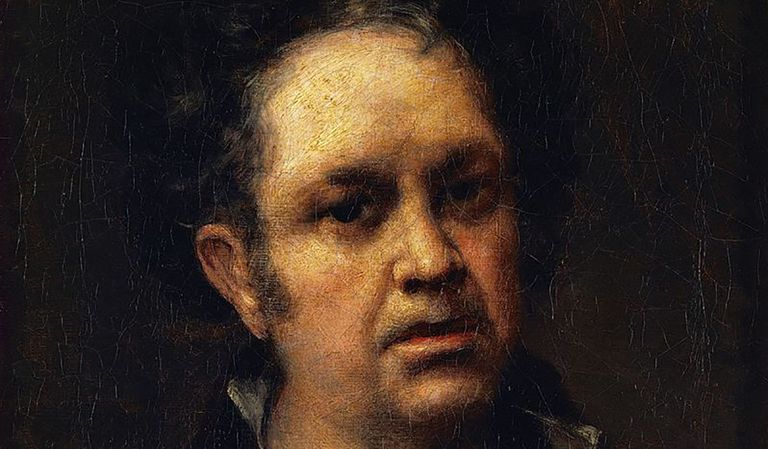
Source: Imagno/Getty Images
Such images were a far cry from his earlier works and could be a reflection of the artist’s mental state. It seems Goya was going through extremely dark moods and used the available blank walls in his house to express himself.
A Brilliant Forgery?
But some claim that Francisco Goya may not have painted The Black Paintings himself. An art historian named Juan Jose Junquera revealed that some words in the paintings weren’t in use until the 1870s. Considering that Goya passed away in 1828, Junquera believes that Goya’s son may have painted the images.
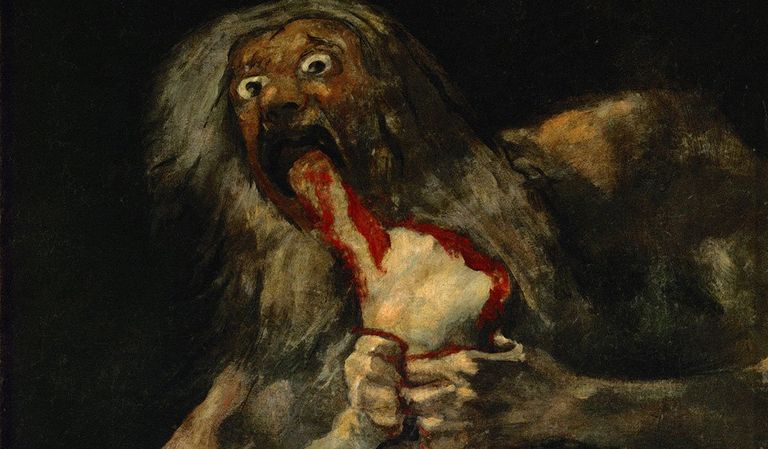
Source: Imagno/Getty Images
Experts claim that Goya’s son may have passed the paintings off as his father’s work in order to sell his father’s property at a higher price.
Who Was The Real Mona Lisa?
The Mona Lisa is one of the most popular paintings in the entire art world. Many experts agree that the artwork features Lisa Gherardini–the wife of a merchant from Florentine who commissioned Leonardo da Vinci to paint the portrait.
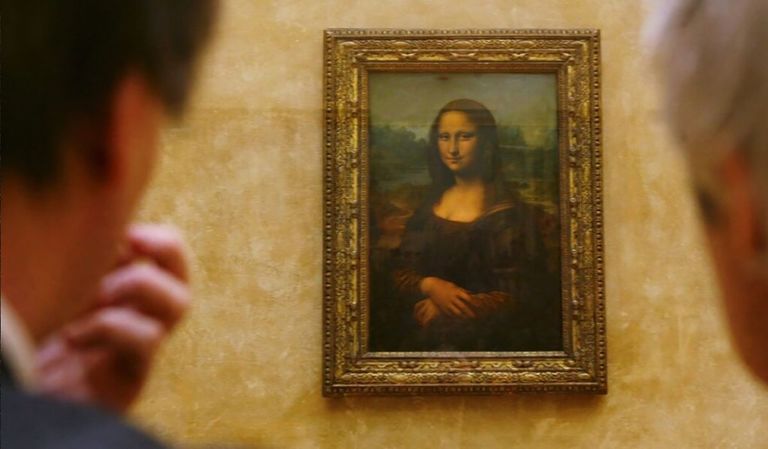
Source: Raphael GAILLARDE/Gamma-Rapho via Getty Images
However, there is no end to the conspiracy theories about this famous painting. Some point to the Mona Lisa’s lack of eyebrows and eyelashes as a sign that the Mona Lisa may not be a woman at all. Was this a portrait of a real woman or just a figment of Leonardo’s imagination?
Was Da Vinci Actually Mona Lisa?
Conspiracy theorists claim that the Mona Lisa is actually a self-portrait of Leonardo da Vinci himself, disguised as a woman. Even the Italian government is taking this theory seriously.
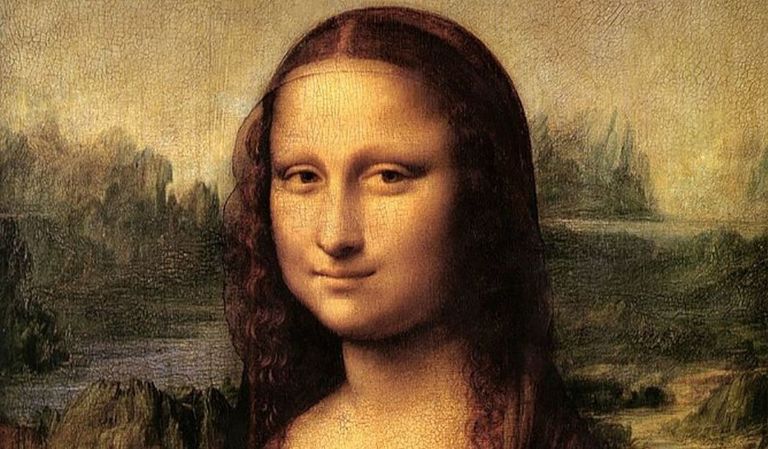
Source: Universal History Archive/Getty Images
But why would Leonardo paint himself as a woman? The world may never know. A committee proposed exhuming da Vinci, but perhaps digging up a 500-year-old corpse might not be the best way to prove it.
Michelangelo's Messages On The Ceiling Of The Sistine Chapel
The Sistine Chapel is the ultimate masterpiece of art. It is also rich in conspiracy theories. Some claim that Michelangelo’s frescoes in the Sistine Chapel are not just beautiful pieces of art but a secret message to the world.

Source: Hulton Archive/Getty Images
Michaelangelo spent ten years completing biblical figures and scenes, and many claim that the artist used his artwork to express his views and feelings about the Catholic Church.
An Impolite Gesture
A particular piece on the Sistine Chapel ceiling is The Prophet Zechariah. Apparently, it reveals Michelangelo’s true feelings about the Catholic Church, as some say the prophet’s face is none other than Michelangelo himself.

Source: Fotopress/Getty Images
Also, one of the two floating cherubs behind the prophet has its thumb tucked between its index and middle finger–a gesture that in the olden days had the same meaning as today’s middle finger. Could it be an indication that Michelangelo had a bone to pick with the Pope and the Church?
A Not So Holy Light
The Annunciation with Saint Emidius is a painting that’s considered not just a religious masterpiece but also a treasure trove for conspiracy theories. The painting was created by Carlo Crivelli for the Church of S.S. Annunziata in Italy, and it’s chock-full of religious symbols.
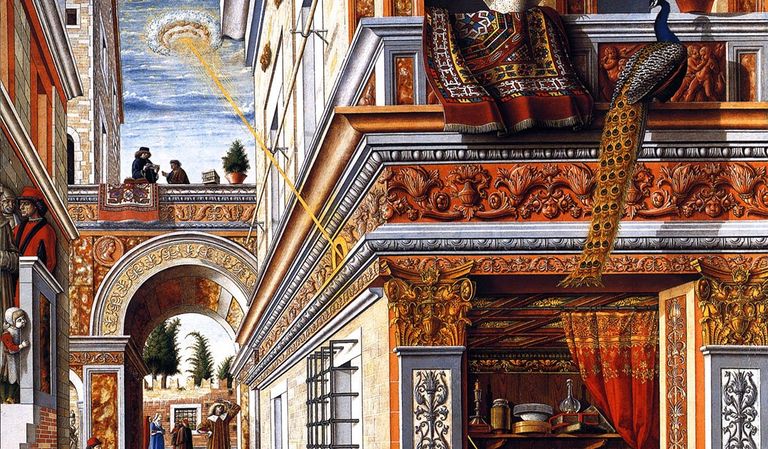
Source: Universal History Archive/Getty Images
The painting features an apple in the foreground to represent the sin and the fall of man. It also shows the town’s patron saint, Saint Emidius, as he chats with the angel Gabriel. However, it’s the overhead ray of light that remains a mystery to this day. Some say it’s a symbol of divine intervention, while others claim it’s a secret message from something totally unexpected.
A Close Encounter Of The Sacred Kind?
The Annunciation with Saint Emidius is a painting that seems to present potential proof of extraterrestrial life. Traditionally, the light from heaven, as seen in the painting, is a symbol of the moment Mary became pregnant.

Source: KTSDESIGN/SCIENCE PHOTO LIBRARY/Getty Images
However, some people see something different. They think Crivelli, the artist, incorporated a UFO into the painting. Conspiracy theorists believe that the overhead ray of light is a depiction of a flying saucer as its shape and color are too similar to the depiction of UFOs in popular culture.
Jack The Ripper Was An Artist?
The greatest mystery of all time–the true identity of Jack the Ripper–has not yet been solved. Although he’s one of history’s most notorious serial criminals, no one knows who he really was for sure.
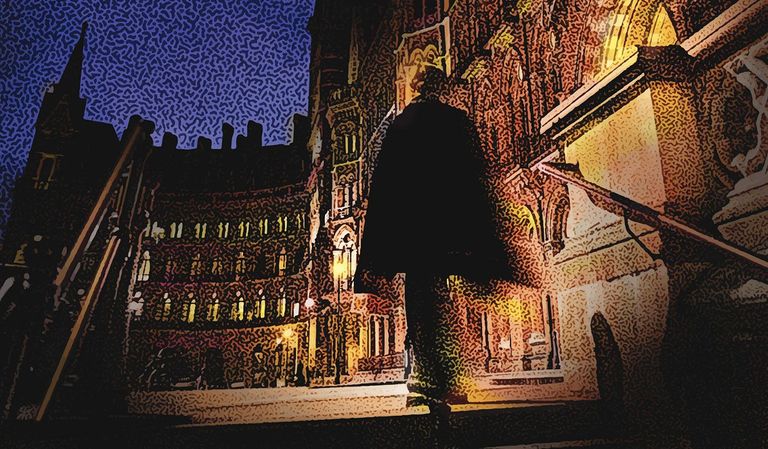
Source: GeorgePeters/Getty Images
Though a lot of names have been thrown around over the years as potential suspects, it was in 2001 when a writer named Patricia Cornwell came up with a possible theory on who Jack The Ripper was.
The Paintbrush Is More Powerful Than The Sword
The true identity of Jack the Ripper was actually British artist Walter Sickert–based on Patricia Cornwell’s theory. Sickert was known for strange subject matters in his artwork, including nudes, nightlife, and dancers in London and Paris.
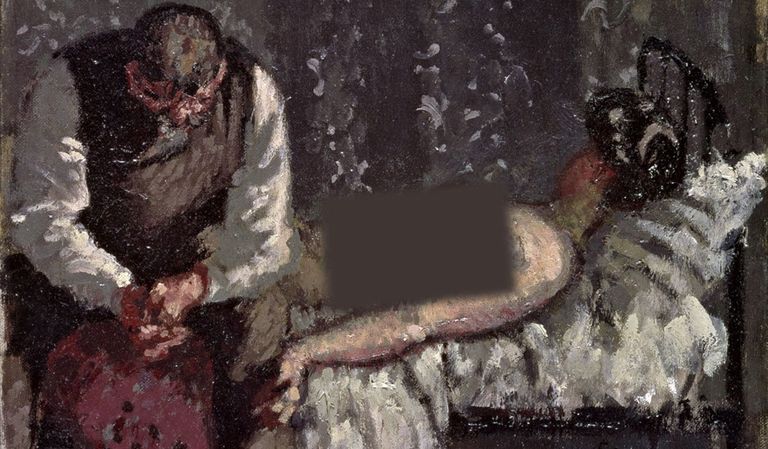
Source: Walter Sickert
But the most incriminating piece of evidence was Sickert’s painting called The Camden Town Murder, which Cornwell found eerily similar to a Jack the Ripper crime scene. However, since there’s no concrete evidence to link the artist to the infamous slasher, this theory remains just that.
A Painting Destroyed
The greatest art controversy of all time was the destruction of Diego Rivera’s mural. Nelson Rockefeller, a businessman, and politician, hired the famous artist to paint a mural for New York City’s Rockefeller Center. The original piece was called Man at the Crossroads. However, the artwork, unfortunately, suffered an untimely demise.
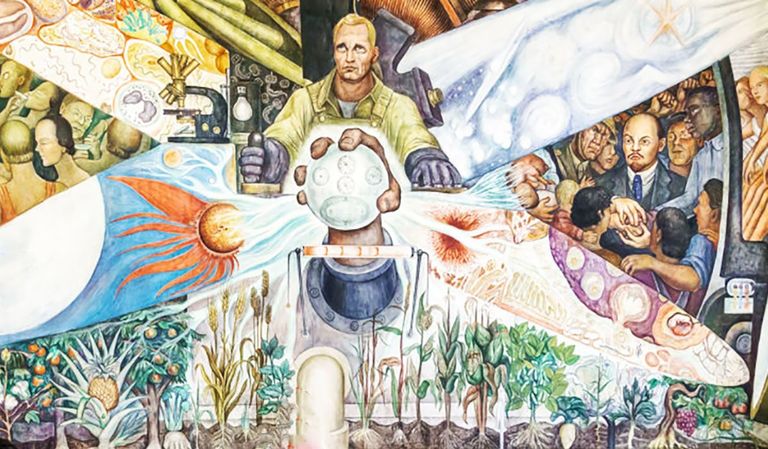
Source: Jeffrey Greenberg/Universal Images Group via Getty Images
When Rockefeller realized that Rivera had painted Communist leader Vladimir Lenin into the piece, he had the painting destroyed.
Rivera’s Revenge
The greatest act of artistic revenge of all time was Diego Rivera’s mural, Man, Controller of the Universe. When his original mural was destroyed by Nelson Rockefeller, Rivera decided to take his revenge. He traveled to Mexico City, where he painted a new version of the mural.
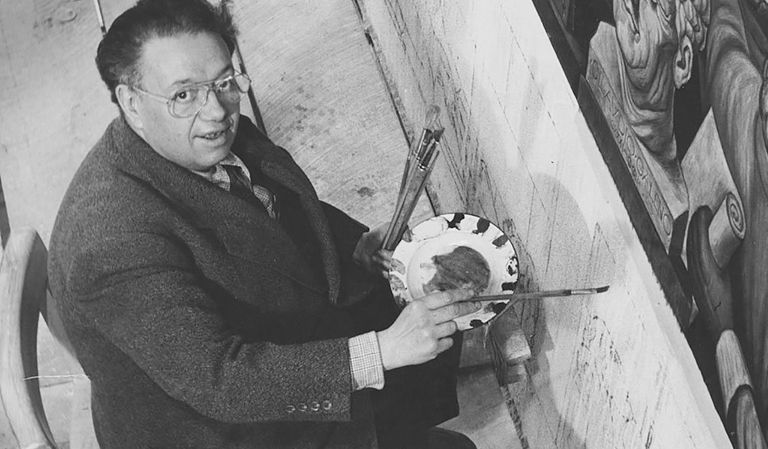
Source: FPG/Getty Images
The only difference was that he used Nelson’s grandfather, John D. Rockefeller, as the subject. He also added an unexpected twist. He painted the billionaire’s form beneath the syphilis bacterium to tell the world that John D. Rockefeller had a sexually transmitted infection.
The Virgin Mary Is Not In Michelangelo’s Pietà?
Michaelangelo’s Pieta features Jesus’ demise after being nailed to the cross. Cradling him is his mother, the Virgin Mary. Many have praised the sculpture for its meticulous rendition of a biblical situation.
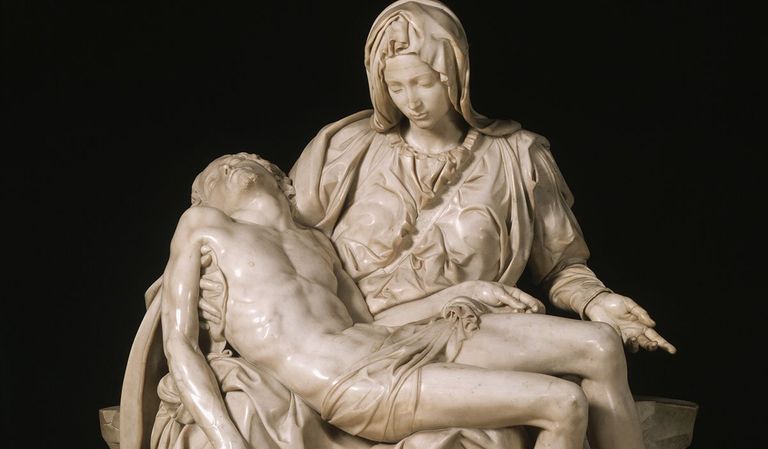
Source: Araldo de Luca/Corbis via Getty Images
However, a lot of people have questioned the artwork. Many believe that the woman was actually not the prophet’s mother due to the slew of clues that seem to indicate that it was not the Virgin Mary carrying Jesus’ lifeless body.
Mary Magdalene Or The Virgin Mary?
Michelangelo’s Pietà seems to present a sculpture, not of the Virgin of Mary but of Mary Magdalene. She may be the woman holding Jesus’ lifeless body due to her youthful appearance. She is too young to have given birth and raised a grown man.
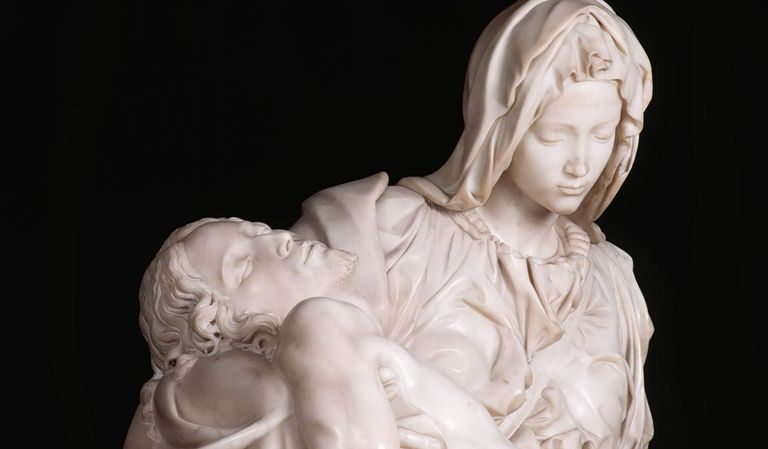
Source: Araldo de Luca/Corbis via Getty Images
There is also available information that shows Michelangelo’s initial prototype of the sculpture. Apparently, he included a miniature carving of Cupid. Therefore, this adds basis to the theory that it was Mary Magdalene who held Jesus’ body because they were actually husband and wife.
A Sinister Saint John the Baptist
Considering that da Vinci is included numerous times in this list, it is safe to assume that da Vinci was highly likely hiding tons of symbols and messages in his artwork. One of his paintings, Saint John the Baptist, was purportedly his final work prior to his demise in 1519.
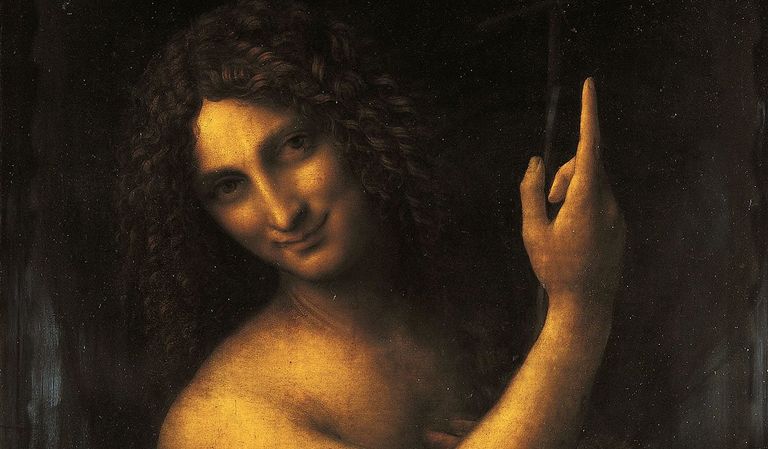
Source: DeAgostini/Getty Images
The painting can be seen in Paris, France’s Musee du Louvre, and shows Saint John gesturing toward the sky as if to suggest the value of salvation once baptized in the Holy Spirit. However, many were disturbed by how John the Baptist was represented.
An Alien In The Painting?
Conspiracy theorists propose a strange theory about the painting. Though Saint John the Baptist seems an obvious depiction of the popular biblical figure, many saw something totally different when they mirror-imaged the painting beside itself.
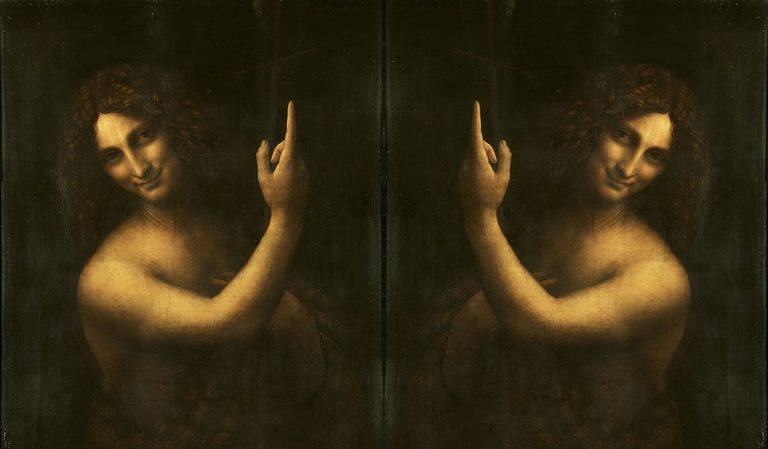
Source: Fine Art Images/Heritage Images/Getty Images
Apparently, when this is done, along with making the canvas brighter, a mysterious figure appears in the middle of the painting. Some interpret the image that appeared as an alien. However, some argue that da Vinci’s John The Baptist looks more like a hermaphrodite and seems an unworthy representation of the saintly figure.
9/11 Was Predicted By Anthony Quinn?
Hollywood actor Anthony Quinn was not just into movies–he also apparently had precognitive skills. According to a 2017 book by Glenn Harte titled The Prophetic Imagery of Anthony Quinn, it seemed the Academy Award-winning thespian also had skills that allowed him to communicate with the dead.
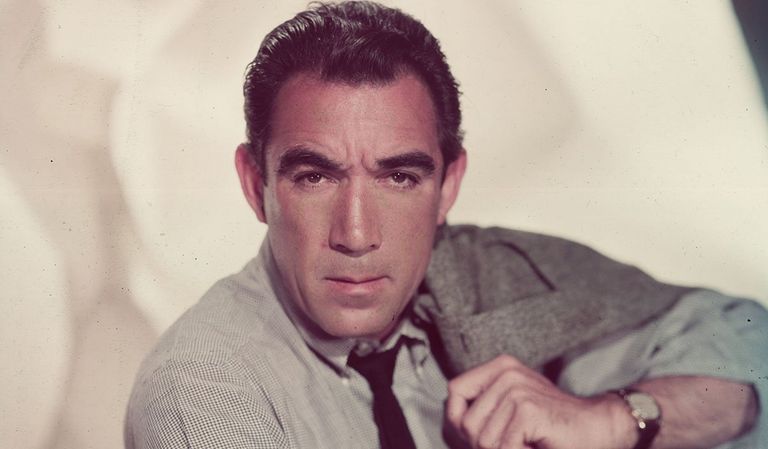
Source: Hulton Archive/Getty Images
Harte told the story of how the spirit of post-impressionist artist Paul Gauguin was on the set of the film Lust for Life. The movie featured the life of Van Gogh and also featured Gauguin. Apparently, Gauguin’s ghost helped the actor hold the paintbrush properly. As a result, Quinn won an Oscar for his performance.
Scary Imagery
However, Quinn’s psychic skills were not constricted to his acting career. Harte further told The Hollywood Reporter that a painting made by Quinn in 1985 called Facets of Liberty was oddly similar to the terrorist attacks that occurred on 9/11.
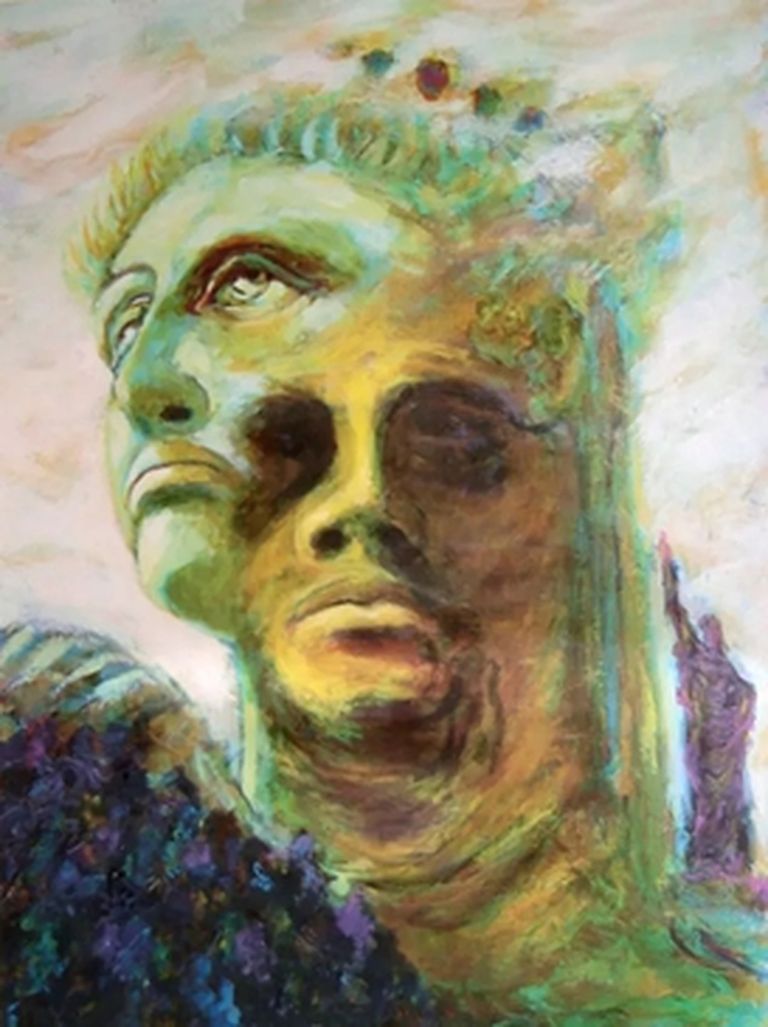
Source: Anthony Quinn/Wikimedia Commons
Harte found identical shocking details of what happened in New York City and Quinn’s artwork. He was surprised that the painting included firefighters, a smoke-filled sky, as well as planes that were crashing into a tall tower.
